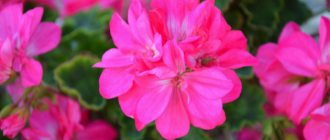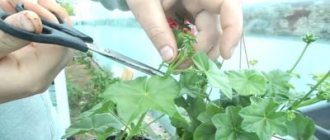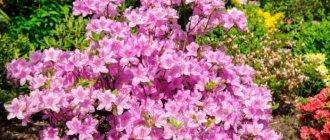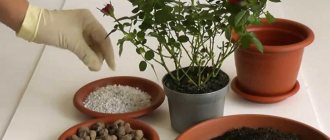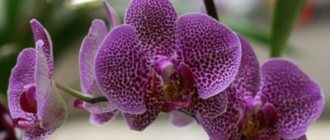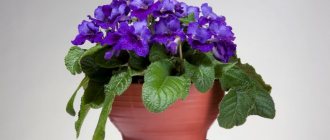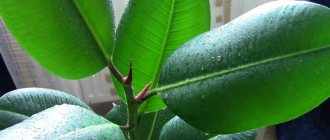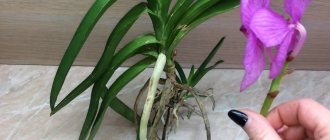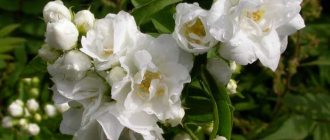Royal pelargonium, Pelargonium grandiflorum or regale, differs from its closest relatives in its most magnificent flowering and somewhat more whimsical character.
Description of royal geranium
Royal pelargonium is considered one of the beautiful flower hybrids. The Cape region, located in southwest Africa, is considered to be its homeland. The height of the bush does not exceed 50 cm, while the flowers are located at the level of the foliage.
The inflorescences can reach 15 cm in diameter. The color varies from white to dark, similar to black. There is mainly a palette of scarlet shades. The petals are arranged in two, sometimes three rows. The upper one is distinguished by a bright, rich hue, often with a spotted pattern or veins. Externally similar to pansies.
The leaves are dense, velvety, with wavy edges, sometimes with small teeth. Arranged alternately on the cuttings. Color green. The stem is straight, latent. The root system consists of adventitious roots.
Candy Flowers
Varieties and types of royal geranium
Scientists from Germany have bred more than a thousand varieties. The most common types among gardeners are two: Candy Flowers and Angels. Both have lush flowering and are easy to care for.
| View | Description | Application | Varieties, inflorescences |
| Candy Flowers | Selective hybrid of pelargonium with the Angels variety. | Planted in open ground, similar to the parent group (Angels) in terms of growing and maintenance conditions, does not require wintering, blooms even in extreme heat. | It is distinguished by large flowers.
|
| Angels | They do not have a wintering period, they bloom magnificently, but for a short time (one month - August), in some varieties the foliage has a rich aroma, thanks to the participation of curly pelargonium in the hybridization of the variety. The storage of the trunk allows you to give the bush an ampelous appearance. | Used in breeding the Candy Flowers species. | Small flowers on a low stem, similar to pansies.
|
Angels
Unusual varieties of royal geraniums
Among the hybrids, scientists managed to obtain varieties with an unusual structure and bright colorful flowers.
| Variety | Flowers | Peculiarities |
| Sally Munro | The top is rich red, the bottom is pale pink. | They bloom several times per season. |
| Mona Lisa | White. | It stands out for its lush flowering among varieties with snow-colored flowers. |
| Georgina Blythe | Orange with a scarlet tint, whitish wavy edges and a center. | Does not exceed 35 cm in height. |
| Morwenna | Rich dark burgundy shade. | The tone is close to black. |
Basic rules for home care
Royal geraniums at home require special care. The gardener should make an effort to ensure that the flower grows and blooms.
| Factor | Conditions | |
| Spring Summer | Winter | |
| Location | Place it on the windowsill on the sunny side. | Place in a cool place, away from heating appliances. |
| Temperature | +20…+25 °C | +17…+19 °C |
| Lighting | Avoid exposure to direct sunlight. In this case, the plant is shaded. | Use phytolamps for additional light. |
| Humidity | Increased, depends on the temperature of the room. In dry air, spraying can be used, but not excessively. | |
| Pot | Choose narrow and shallow. Royal geranium loves cramped spaces and does not tolerate frequent transplants. Material: unglazed ceramics. | |
| Watering | Twice a day, 50 ml/time per plant, through a tray. The water is settled and kept in the same room as the flower so that its temperature corresponds to room temperature. Use boiled, rain water. Do not spray. | Reduce, water once a day when the top layer of the earthen clod dries. |
| Top dressing | Mineral once a week, 2-3 months before flowering, they begin to add fertilizers, including phosphorus and potassium. For young people, special complexes are used. It is not recommended to resort to organics. | Does not require additional feeding. |
| Trimming | They don't. | It is carried out after the end of flowering, in the fall, in two stages, the interval between them is 45-50 days. |
When the plant goes to sleep
During the period from October to March, royal pelargonium is in a dormant stage. The main thing at this time is to prevent the earthen lump from becoming too dry. The flower practically does not need particularly complex care at this time of year. In advance, before it enters the dormant stage, weak leaves should be cut off. The remaining flowers and shoots are cut to a third in length.
These measures are designed to provide the flower with maximum opportunities for future growth and oxygen production. Another undoubted advantage of the pruning procedure is improved resistance to pests and diseases. At this time, pelargonium should be watered only when the situation requires it. The temperature during hibernation should be maintained at about 10-14 degrees Celsius.
Sometimes individual gardeners do not have the time or a suitable place to properly care for the plant in winter. In this case, we can recommend the following measure: remove all plants from the pots, shorten their leading shoots, clean the root ball of each plant from dirt and lightly trim the roots.
Then all the plants are separately wrapped in newspaper and wrapped with film on top, after which they are tied and hung in the basement. In this case, you will be spared the need to care for the flower throughout the long winter.
In March, pelargonium should be removed from the packages and planted back into pots.
Features of summer care at home
Pelargonium blooms in summer. The flower only needs watering and feeding. If he is in the fresh air, then carefully monitor the temperature. At values below +22...+24 °C, watering is reduced, below +10 °C, and the uniformity of drying of the earthen clod is regularly checked. Excessive moisture can cause root rot and mold growth. It is recommended to water in the early morning before the heat sets in or in the evening, when the sun no longer shines and goes into sunset.
For feeding, fertilizers with minimal or no nitrogen content are used.
On the street, pelargonium is constantly checked for pests. When they are detected, they are immediately treated with an insecticide so that the plant does not get sick or die. When choosing a location, avoid direct light.
The sun's rays may leave burn marks on the foliage or it will change color to scarlet. Royal geranium does not tolerate changing places well, so it is advised not to plant it in open ground or to do it together with a pot to preserve the rhizome from insect attacks.
Let's talk about pests
The most dangerous and most common disease of royal geranium is called black leg. Its sign is the plant stems painted black at ground level. You should carefully monitor the flower, as the disease can spread quickly and affect the entire plant.
The reason for this is most often too high humidity or waterlogged soil. To prevent this problem, care should be taken to ensure optimal conditions for the development of royal pelargonium, including relative dry air.
Another problem with geraniums is rust. Affected leaves turn yellow and subsequently die. In addition to leaves, flowers with shoots are also susceptible to this disease. That is why, if you find signs of rust on the leaves of a plant, you should immediately tear off those that are affected. This measure serves as an effective prevention against the spread of this unpleasant disease.
Well, now all our readers know that under this luxurious name hides the familiar indoor geranium for many of us. A plant familiar to everyone can effectively decorate not only the windowsill of an apartment, but also an open balcony or garden plot.
If you take care to create favorable conditions for the growth of pelargonium, you will be rewarded for your efforts. Otherwise, waiting for this unpretentious beauty to bloom will be problematic.
Landing of a royal beauty
Frequent transplants for Royal geraniums are a source of stress, so they are carried out only after the root system has completely filled the space in the pot.
The optimal time is the end of winter - the beginning of spring, before flowering. The dishes are chosen with a diameter 1.5-2 cm larger. Drainage is laid out at the bottom and covered with a layer of cotton fabric on top. This will help retain the soil. The substrate can be purchased at the store. It is necessary to ensure that it does not contain components that retain moisture. When preparing it yourself, use peat, humus and sand (1:1:1). To improve the quality and create a slightly alkaline environment, ash is added. The soil should be nutritious and loose in consistency.
If the flower was purchased in a store, then you need to wait until the end of flowering and give it time to adapt to the new place. Only then proceed to transplantation.
The process begins with abundant watering, then the plant, together with a damp earthen ball, is placed in a prepared container. The free space is filled with fresh soil.
Several scientific terms
What kind of plant is this - royal pelargonium? Looking into specialized literature, the reader will find that this beautiful flower is also known under other names. It is called pelargonium grandiflora or royal geranium.
The scientific name of the plant is Pelargonium grandiflorum or Regal Pelargonium. Pelargonium belongs to the Geraniaceae family. As a rule, it grows no higher than 25-50 cm.
This plant has gained wide popularity as a ubiquitous indoor house flower. This is explained by the presence of a long flowering period and the inherent unpretentiousness in care. Amateur flower growers can propagate royal pelargonium quite easily and effectively through the use of cuttings.
Reproduction
Propagated in two ways: cuttings and seeds. The first is simpler, in the second case the flowering will be longer, the root system will be developed and strong.
Cuttings
For planting, use the top shoots 7-10 cm long with 2-3 nodes on each, obtained during spring pruning. Dry them for two hours after cutting.
The resulting material is planted in the soil, not placed in water, where it can rot and not take root. The soil for planting is prepared in advance. For this:
- prepare a mixture of perlite and earth (1:1);
- disinfect the resulting substrate in the oven or using a solution of potassium permanganate;
- leave it to stand for two days.
Before planting, the bottom of the shoot is sprinkled with Kornevin’s preparation, then it is planted in a prepared container and buried 2 cm into the soil. Leave in dim light and temperature +14…+16 °C. Water through a tray to prevent the roots from rotting from excess moisture.
The planted shoot takes root within a week, then it can be transplanted into a pot. When the shoots are planted in prepared soil, they are not covered with film, creating a greenhouse effect. To strengthen the rhizome, emerging leaves are cropped so that the plant does not waste its energy on them.
To simplify the procedure for planting cuttings, use a peat tablet. In this case, the tray with them is placed on the windowsill, protected from direct rays of the sun. Scald with boiled water, left for 3 days, for disinfection; after the moisture has been absorbed, the excess is drained. The cuttings are dipped in a root system growth accelerator; this condition is mandatory for Royal Pelargonium. Then the tablets are planted in the center and buried by one third. The substrate is pressed tightly to eliminate excess water. A greenhouse is not created, spraying is not carried out, this is contraindicated. After the roots appear, carefully make cuts on the sides with scissors and remove the tablet. Those places where the roots have grown into it are not touched. The seedlings are placed in plastic cups where they continue to grow.
Propagation by seeds
Reproduction material is purchased at the store. Sow at the end of February, before flowering begins. The substrate is prepared from peat and sand (1:1), ash is added. Disinfect by calcination or a solution of potassium permanganate. The seeds are small, elongated. They are buried 5 mm into the soil. The seedlings are covered with film, a greenhouse effect is created and placed in a warm place with bright, diffused light and a temperature of +21...+25 °C.
In a month the first shoots will appear. As soon as they have released two leaves, they are planted in separate pots with a diameter of 10 cm and a depth of 14 cm. A layer of drainage is laid on the bottom. After the 5th leaf appears, pinching begins to give it shape and get more side shoots to make the bush fuller.
Mr. Summer Resident warns: possible problems when growing royal geraniums
Large-flowered geranium has its own nuances in care. If you do not follow them, you may encounter a flower disease or a change in appearance. It won't bloom.
| Problem | Cause | Elimination |
| The trunk is rotting (blackleg disease) | Low temperature, excessive or improper watering. | The plant and soil are affected and must be disposed of. The window sill and pot must be treated with chloride. |
| Mites, weevils, aphids, whiteflies | Infestation with parasites. | Wipe the back of the leaves with chamomile infusion and leave for a couple of hours, then rinse. If the decoction does not help, apply an insecticide. |
| No flowering | Low temperature, dry air, insufficient lighting, improper pruning, large pot volume, soil oversaturated with nutrients, nitrogen present, inappropriate fertilizer or lack thereof. | Correct deficiencies in care and create comfortable conditions. |
| The foliage is yellow, falls off, the stem grows, but does not bloom | Little light. | Add light using phytolamps. |
| Green, but lethargic, watery pads have formed. | Over-watering can lead to a disease - gray rot, then the affected foliage is removed and the plant is treated with drugs. | Reduce watering. |
| The ends turn yellow | Lack of moisture. | Increase the amount of moisture supplied. |
| Scarlet shade | Low temperature, drafts. | Move to a warm place with optimal performance. |
Diseases
Gray rot - develops due to excess moisture and high nitrogen content in the soil. It appears as brown spots on the leaves and stems, and a gray coating on the flower. For treatment, the plant is transplanted into new soil and treated with fungicidal agents.- Root and stem rot - the root collar becomes black and begins to rot, the leaves turn pale, turn yellow and wither. The reason is an excess of moisture and low acidity of the soil. To combat rot, the drugs “Biporam” or “Fitolavin” are used.
- Late blight is a fungal infection that causes the plant to wither and rot. The disease appears due to high humidity. As a result, the leaves become pale and the flower slows down its growth. White fluff may form in places of rot. The plant must be treated with Bordeaux mixture. The damaged parts are removed, the cut areas are treated with charcoal, and the plant is transplanted into new soil.
- Edema - the formation of tubercles and growths on the leaves. It also occurs due to waterlogging. Damaged leaves are cut off and watering is reduced.
- Verticillium wilt is the most dangerous disease. The infected plant must be destroyed. If the first signs of disease appear on the shoots, they need to be cut off and the flower treated with a biofungicide.
